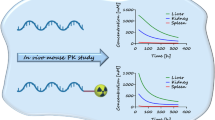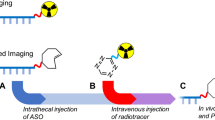Abstract
Purpose. To compare the pharmacokinetics and bioavailability of an oligonucleotide delivered in a free form or using cationic or anionic synthetic carrier systems.
Methods. Whole body dynamic quantitative imaging and metabolism of a HIV antisense oligonucleotide intravenously administered either free or incorporated into synthetic carriers were compared in baboons, using non invasive positron emission tomography and an enzyme-based competitive hybridization assay, respectively.
Results. In its free form, the oligonucleotide showed high liver and kidney concentration, rapid plasmatic degradation and elimination from the body. Use of a cationic vector slightly protected the oligonucleotide against degradation and enhanced uptake by the reticulo-endothelial system. In contrast, the anionic vector dramatically enhanced the uptake in several organs, including the lungs, spleen and brain, with a prolonged accumulation of radioactivity in the brain. Using this vector, intact oligonucleotide was detected in plasma for up to two hours after injection, and the T1/2β and distribution volume increased by 4- and 7-fold, respectively. No evidence of toxicity was found after a single dose administration.
Conclusions. The anionic vector improves significantly the bioavailability and the pharmacokinetics of the oligonucleotide, and is a promising delivery system for in vivo administration of therapeutic nucleic acids.
Similar content being viewed by others
REFERENCES
C. A. Stein. Phosphorothioate antisense oligodeoxynucleotides: questions of specificity. Trends Biotechnol. 14:147–149 (1996).
A. Prochiantz. Peptide nucleic acid smugglers. Nat. Biotechnol. 16:819–820 (1998).
P. L. Felgner, Y. Barenholz, J. P. Behr, S. H. Cheng, P. Cullis, L. Huang, J. A. Jessee, L. Seymour, F. Szoka, A. R. Thierry, E. Wagner, and G. Wu. Nomenclature for synthetic gene delivery systems. Hum. Gene Ther. 8:511–512 (1997).
A. R. Thierry, P. Rabinovich, B. Peng, L. C. Mahan, J. L. Bryant, and R. C. Gallo. Characterization of liposome-mediated gene delivery: expression, stability and pharmacokinetics of plasmid DNA. Gene Ther. 4:226–237 (1997).
R. J. Lee and L. Huang. Lipidic vector systems for gene transfer. Crit. Rev. Ther. Drug Carrier Syst. 14:173–206 (1997).
T. Jones. The imaging science of positron emission tomography. Eur. J. Nucl. Med. 23:807–813 (1996).
T. Jones. The role of positron emission tomography within the spectrum of medical imaging. Eur. J. Nucl. Med. 23:207–211 (1996).
B. Tavitian, S. Terrazzino, B. Kuhnast, S. Marzabal, O. Stettler, F. Dollé, J. R. Deverre, A. Jobert, F. Hinnen, B. Bendriem, C. Crouzel, and L. Di Giamberardino. In vivo imaging of oligonucleotides with positron emission tomography. Nat. Med. 4:467–471 (1998).
J. R. Deverre, V. Boutet, D. Boquet, E. Ezan, J. Grassi, and J. M. Grognet. A competitive enzyme hybridization assay for plasma determination of phosphodiester and phosphorothioate antisense oligonucleotides. Nucleic Acids Res. 25:3584–3589 (1997).
C. Lavigne, J. Yelle, G. Sauvé, and A.R. Thierry. Lipid-based delivery of combinations of antisense oligodeoxynucleotides for the in vitro inhibition of HIV-1 replication. AAPS Pharm. Sci. 3:7 (2001).
F. Dollé, F. Hinnen, F. Vaufrey, B. Tavitian, and C. Crouzel. A general method for labeling oligodeoxynucleotides with 18F for in vivo PET imaging. J. Label Compounds Radiopharm. 39:319–330 (1997).
C. Lavigne and A. R. Thierry. Enhanced antisense inhibition of human immunodeficiency virus type 1 in cell cultures by DLS delivery system. Biochem. Biophys. Res. Commun. 237:566–571 (1997).
M. Schmutz, D. Durand, A. Debin, Y. Palvadeau, A. Etienne, and A. R. Thierry. DNA packing in stable lipid complexes designed for gene transfer imitates DNA compaction in bacteriophage. Proc. Natl. Acad. Sci. USA 96:12293–12298 (1999).
MP. Audrezet, G. Le Bolch, V. Floch, JJ. Yaounac, JC. Clement, H. des Abbayes, B. Mercier, A. Paul, and C. Ferec. Novel cationic phospholipids agents for gene transfer to a Cystic fibrosis cell line. J. Liposome Res. 7:273–300 (1997).
S. Agrawal, J. Temsamani, W. Galbraith, and J. Tang. Pharmacokinetics of antisense oligonucleotides. Clin. Pharmacokinet. 28: 7–16 (1995).
C. Plank, K. Mechtler, F. C. Szoka, Jr., and E. Wagner. Activation of the complement system by synthetic DNA complexes: a potential barrier for intravenous gene delivery. Hum. Gene Ther. 7:1437–1446 (1996).
A. R. Thierry. Optimization of lipoplex formulations for intravenous gene delivery. J. Liposome Res. 7:143–159 (1997).
A. R. Thierry and A. Dritschilo. Intracellular availability of unmodified, phosphorothioated and liposomally encapsulated oligodeoxynucleotides for antisense activity. Nucleic Acids Res. 20: 5691–5698 (1992).
R. L. Juliano and S. Akhtar. Liposomes as a drug delivery system for antisense oligonucleotides. Antisense Res. Dev. 2:165–176 (1992).
C. Ropert, Z. Mishal, Jr., J. M. Rodrigues, C. Malvy, and P. Couvreur. Retrovirus budding may constitute a port of entry for drug carriers. Biochim. Biophys. Acta 1310:53–59 (1996).
D. C. Litzinger. Limitations of cationic liposomes for antisense oligonucleotide delivery in vivo. J. Liposome Res. 7:51–61 (1997).
J. P. Yang and L. Huang. Overcoming the inhibitory effect of serum on lipofection by increasing the charge ratio of cationic liposome to DNA. Gene Ther. 4:950–960 (1997).
A. R. Thierry and L. C. Mahan. Therapeutic Applications of lipid-based Gene Delivery systems. In A. Rolland (ed.), Advanced Gene Delivery, Harwood Academic, Amsterdam, pp 124–137 (1998).
A. R. Thierry, Y. Lunardi-Iskandar, J. L. Bryant, P. Rabinovich, R. C. Gallo, and L. C. Mahan. Systemic gene therapy: biodistribution and long-term expression of a transgene in mice. Proc. Natl. Acad. Sci. USA 92:9742–9746 (1995).
O. A. Sedelnikova, I. G. Panyutin, A. R. Thierry, and R. D. Neumann. Radiotoxicity of iodine-125-labeled oligodeoxyribonucleotides in mammalian cells. J. Nucl. Med. 39:1412–1418 (1998).
R. Zhang, R. B. Diasio, Z. Lu, T. Liu, Z. Jiang, W. M. Galbraith, and S. Agrawal. Pharmacokinetics and tissue distribution in rats of an oligodeoxynucleotide phosphorothioate (GEM 91) developed as a therapeutic agent for human immunodeficiency virus type-1. Biochem. Pharmacol. 49:929–939 (1995).
P. L. Iversen, J. Mata, and W. G. Tracewell. and G. Zon. Pharmacokinetics of an antisense phosphorothioate oligodeoxynucleotide against rev from human immunodeficiency virus type 1 in the adult male rat following single injections and continuous infusion. Antisense Res. Dev. 4:43–52 (1994).
F. I. Raynaud, R. M. Orr, P. M. Goddard, H. A. Lacey, H. Lancashire, I. R. Judson, T. Beck, B. Bryan, and F. E. Cotter. Pharmacokinetics of G3139, a phosphorothioate oligodeoxynucleotide antisense to bcl-2, after intravenous administration or continuous subcutaneous infusion to mice. J. Pharmacol. Exp. Ther. 281:420–427 (1997).
R. K. DeLong, A. Nolting, M. Fisher, Q. Chen, E. Wickstrom, M. Kligshteyn, S. Demirdji, M. Caruthers, and R. L. Juliano. Comparative pharmacokinetics, tissue distribution, and tumor accumulation of phosphorothioate, phosphorodithioate, and methylphosphonate oligonucleotides in nude mice. Antisense Nucleic Acid Drug Dev. 7:71–77 (1997).
A. Tari, N. Neamati, M. Andreff, and G. Lopez-Berenstein. Liposomal delivery of P-ethoxy antisense oligonucleotides in chronic myelogenous leukemia. In G. Gregoriadis (ed.), Targeting of drugs: Strategies for oligonucleotide and gene delivery in therapy, Plenum Press, New York, 1996 pp. 163–168. Tavitian et al. 376
Author information
Authors and Affiliations
Corresponding author
Rights and permissions
About this article
Cite this article
Tavitian, B., Marzabal, S., Boutet, V. et al. Characterization of a Synthetic Anionic Vector for Oligonucleotide Delivery Using in Vivo Whole Body Dynamic Imaging. Pharm Res 19, 367–376 (2002). https://doi.org/10.1023/A:1015133205457
Issue Date:
DOI: https://doi.org/10.1023/A:1015133205457




